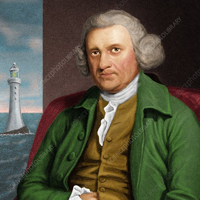John Smeaton
John Smeaton FRS was a British civil engineer responsible for the design of bridges, canals, harbours and lighthouses. He was also a capable mechanical engineer and an eminent physicist. Smeaton was the first self-proclaimed “civil engineer”, and is often regarded as the “father of civil engineering”.
John Smeaton was an English engineer and a physicist, famously known as the ‘Father of Civil Engineering’. He was a master at his work and a self-proclaimed Civil Engineer, an eminent forerunner of his profession. Although initially he pursued the legal profession like his father, later he decided to be an instrument maker. He gained most of his training and scientific knowledge through reading and attending the meetings of Royal Society of London. He constructed bridges, canals and harbors in addition to his works of mechanical engineering. He devised new ways for construction; whether it was the material he used for building or the technique to strengthen the rigidity of the object. Through his dedication and genuine efforts, his every project emerged as a masterpiece, a passionate work of art. He transformed the work of engineering, which was considered as a handicraft work, to a scientific process of experimenting and devising mechanisms in architectural work. He was the first person to coin the term ‘civil engineers’ and also established the first ever engineering society in the world. His earnest work is an inspiration for everyone; to be fearless of the choices they make in life and work with dedication for their dreams to come true. He was born on June 8, 1724 in Austhorpe, Leeds, England. His father was an attorney having a law firm.
In childhood, he used to make hand tools through forging and casting. He made a small lathe for turning wood and also a steam engine which succeeded in pumping out water from his father’s pond. At the age of 16, his father persuaded him to join his law firm. He started legal studies at his father’s office. Two years later, he was about to enter the legal profession formally when he decided to leave it and pursue his dream of being an instrument maker. In 1748, he opened his own shop in Great Turnstile in London with a little knowledge of science and tool-making under his sleeve. His friend, Henry Hindley, helped him to understand the art of making instruments.
In 1750, he collaborated with Dr. Gowin Knight to develop a mariner’s compass, which later became a Royal Navy standard issue. Along with the compass, he also invented a prototype machine to measure the speed of ships, which was not very accurate in heavy seas.In 1751, he moved his shop from Great Turnstile to a larger place in Furnival Inn Court and employed three craftsmen under his supervision.In 1752, he conducted some experiments related to power of windmills and water wheels which were successful and proved his expertise in the knowledge of science and engineering.

John Smeaton
Date of Birth: 08 Jun 1724
Birth Place: Austhorpe, United Kingdom
Proffession: British civil engineer
Nationality: United Kingdom
Death: 28 October 1792, Austhorpe, United Kingdom


